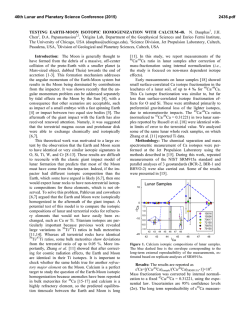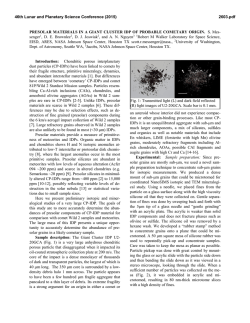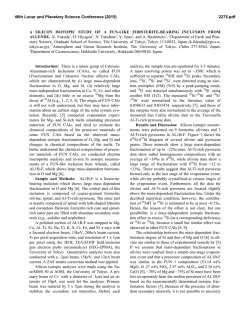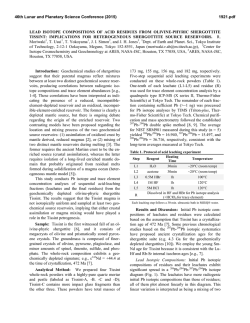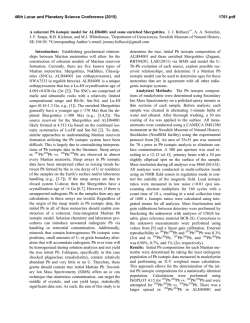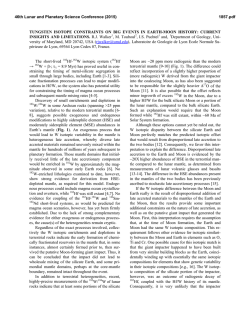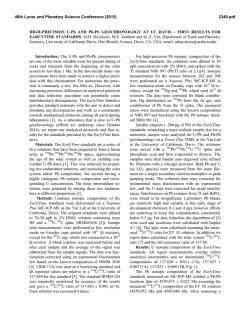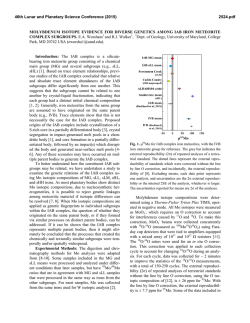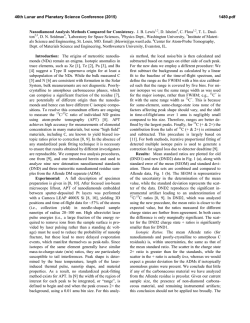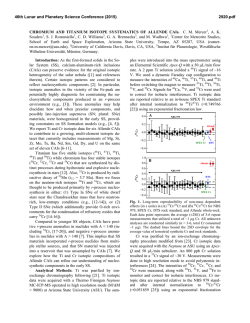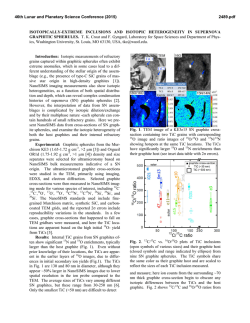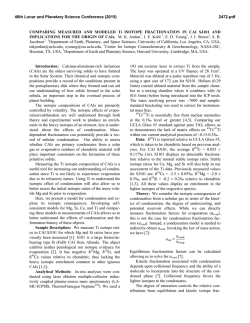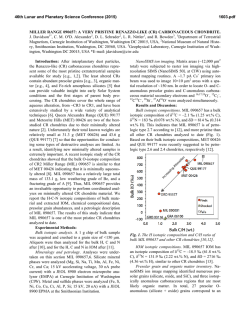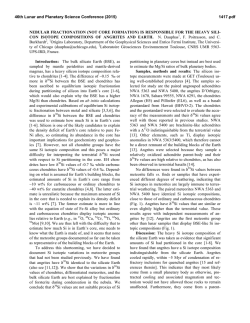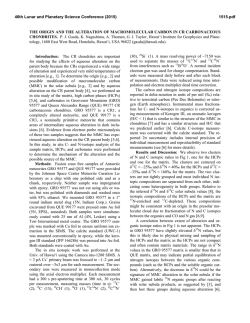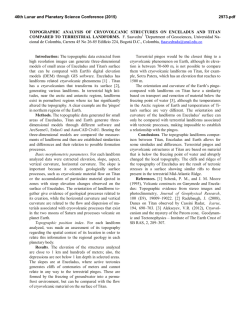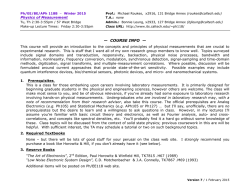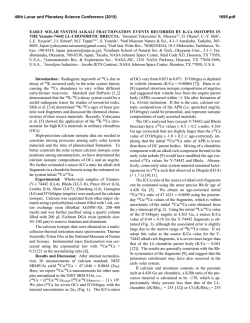
Mass-Dependent Neodymium Isotopic Variations - USRA
46th Lunar and Planetary Science Conference (2015) 2847.pdf MASS-DEPENDENT NEODYMIUM ISOTOPIC VARIATIONS IN PLANETARY MATERIALS— DETERMINED USING A NEODYMIUM DOUBLE SPIKE. R. Andreasen1 and T. J. Lapen1, 1Department of Earth and Atmospheric Sciences, University of Houston, 312 Science & Research Building 1, Houston TX 77204, USA ([email protected]). Introduction: The coupled 146,147Sm-142,143Nd alpha-decay system is a powerful tool for unraveling early silicate differentiation of planetary bodies. Shortlived 146Sm decayed to 142Nd with a half-life in the range of 68-103 Ma [1,2], while long-lived 147Sm decays to 143Nd with a half-life of 106 Ga. Thus variations in the 142Nd isotopic composition tracks differentiation within the first ~300 Ma of Solar System history, while variations in 143Nd continues to track silicate differentiation. Some of the challenges to utilizing the coupled Sm-Nd system are (i) the low Solar System initial abundance of 146Sm (146Sm/144Sm =0.0085) [3] and the fact that 142Nd is the most abundant Nd isotope, resulting in limited variation in the 142Nd composition of usually not more than a few tens of parts per million, and (ii) the fact that 142Nd is the lightest Nd isotope (2-4 amu lighter than 144Nd and 146Nd, used for instrumental mass bias correction (with 146Nd/144Nd = 0.7219). This makes 142Nd analysis prone to analytical artifacts at ppm level [3-5]. Neodymium has five stable non-radiogenic isotopes, which makes it possible to detect & correct for the presence of mass-dependent analytical artifacts. In order to do this successfully, however, it is critical to know that samples and standards have the same stable Nd isotopic composition, and that the instrumental mass bias correction is done with an appropriate, true 146Nd/144Nd ratio. Here, mass-dependent Nd isotopic variation of selected standard materials (JNdi-1 [6], La Jolla Nd [7], Caltech nNd-β [8]), planetary materials, and terrestrial samples are reported. Methods: A 145Nd-150Nd double spike was created with a composition suggested by the calculations of [9]. The data reduction follows the outline derived for Mo by [10]. The analyses were performed on the Nu Instruments Plasma II MC-ICP-MS at the University of Houston. Neodymium is separated from the sample matrix using a two step (Cation + α-HIBA) column chemistry allowing for high Nd yields and low Ce and Sm interferences. Interference levels are monitored on 140 Ce and 147Sm and 149Sm, in an analytical setup previously used to analyze stable Nd isotope variation by Eu addition [11]. Results: The measured 144,145,146,150Nd isotopic composition of the La Jolla and Caltech nNd-β stand- ards relative to JNdi-1 is shown in Fig. 1. The choice of using JNdi-1 as a ‘normal’ standard is based solely on the availability and purity of the standard and does not reflect any evidence of this standard representing bulk Earth composition. The double spike Nd data for La Jolla and Caltech nNd-β is in good agreement with earlier Sm-doped data for La Jolla [12] and Eu-doped data [11] and confirms that these standards are respectively lighter and heavier than JNdi-1 in their Nd isotopic composition. La Jolla additionally suffers from non-mass dependent and should not be used as a standard for high-precision measurements, this has been noted before [13]. +5 JNdi-1 +4 Eu Normalized Nd Double Spiked +3 +2 +1 εNd 142 146 Nd 143Nd 144Nd 145Nd 14 Nd N d 148 Nd 150 Nd -1 -2 -3 -4 Caltech nNd-β nNdEu Normalized Nd Double Spiked -5 Figure 1: Stable Nd isotopic composition of the La Jolla and Caltech nNd-β isotopic standards normalized to 146Nd and relative to the JNdi-1 isotopic standard. The error envelope for the europium normalized data is in good agreement with the double spike data, except for 150Nd for La Jolla, which suffers from non mass-dependent isotope shift [13]. Eu normalized data from [11], double spiked Nd from this study. The double spiked data also confirms that the Nd/144Nd value of these standards is higher than the widely used normalization value of 0.7219. The 146 Nd/144Nd value of JNdi-1 is approximately 0.7227, those of La Jolla and Caltech nNd-β are approximately 0.7225 and 0.7228, respectively (Fig.2). Samples of Xining (L5), and Ochansk (H4) were analysed to investigate whether the chondritic Nd isotopic composition is similar to that of the Earth. Samples of a eucrite (Berthoud) and a shergottite (Zagami) were also analyzed to investigate any plantary scale 146 46th Lunar and Planetary Science Conference (2015) differences. The data are shown in Fig. 2 with the analyses of four igneous terrestrial rock standards. All the data fall in the range observed in the standards. The ordinary chondrites are lighter than the terrestrial rock standards and the eucrite, but not resolveable from the Martian sample. 2847.pdf stable Nd isotopes between chondrites and Earth, care should be taken in ascertaining that observed variations in 142Nd are indeed radiogenic and not due to mass-dependent or nucleosynthetic effects before any inferences on the early evolution of the Earth is made. 0.7229 0.7228 Nd/144Nd Nd/144Nd 0.7228 146 146 0.7227 0.7227 0.7226 0.7226 JN d Ca La i-1 lte Jo ch lla Xi N d Oc nin -β h g Be an (L5 rth sk ) ou (H4 d ) (e Za uc) ga BH mi VO BI 2 RBC 1 R GS - 2 P2 0.7225 OC HED Mars Earth (igneous) Figure 2: Variations in 146Nd/144Nd ratio for the JNdi1, La Jolla, and Caltech nNd-β standards, chondrites Xining (L5) & Ochansk (H4), the eucrite Berthoud, the shergottite Zagami, and four terrestrial igneous rock standards from the USGS. Several terrestrial rock standards and samples were analyzed to investigate the range of mass dependent Nd isotoipic fractionation in the terrestrial system. These data are presented in Fig. 3. The terrestrial samples show less variation than the standards, though there appear to be resolveable difference between the homogenous sample groupings. The heavier Mn nodules show similar δ-values (146Nd/144NdSample/146Nd/144NdJNdi-1 -1) * 103 to those of low-T carbonate samples [14]. The samples from Isua are a meta-sediment, an amphibolites, and an Ameralik dyke, respectively. They all have the same stable Nd isotope composition but appear to be lighter than any of the other terrestrial samples measured. It is not presently clear if these lighter values in the Isua samples relate to their age or to the geologic processes that have acted on these samples. Discussion and Conclusions: Mass-dependent Nd isotopic variations are observed in planetary materials. Terrestrial samples are heavier in their Nd isotopic composition than chondrites. The differences in Nd isotopic composition between planetary bodies appear to be larger than the variations within a single body. It is not known what the cause of this difference is— processing or parent material. Given the difference in JN Ca La di-1 lte Jo ch lla N BH d-β VO BI 2 R BC -1 R GS - 2 PSG 2 R SC -1 OSD 1 M O-1 A NO GD- 1 Am NO A-1 Am ph D-P e ib -1 M rali olit et k e as Dy ed ke im en t 0.7225 Standards Mn Standards Igneous Sedimentary Nodule Isua Figure 3: Variations in 146Nd/144Nd ratio for terrestrial samples, the JNdi-1, La Jolla, and Caltech nNd-β standards (white), four igneous rock standards (green), four sedimentary rock standards (purple), and two Mn nodule standards (yellow) all from the USGS, and three early Archean samples of amphibolite, metasediment, and metadolerite from Isua (pink). The 146Nd/144Nd ratio of all materials measured is significantly higher than the 0.7219 value commonly used for the normalization of radiogenic Nd isotope data, including high-precision 142Nd data. This ~1100 ppm discrepancy for JNdi-1 (with a 146Nd/144Nd value of 0.7227), may lead to the introduction of analytical artefacts, if the assumption of homogenous evaporation of a sample during TIMS analysis is not satisfied. References: [1] Kinoshita N. et al. (2012) Science, 335, 1614–1617. [2] Meissner F. et al. (1987) Z. Phys A. 327, 171-174 [3] Boyet M. et al. (2010) EPSL, 291, 172-181. [3] Upadhyay D. et al. (2008) JAAS, 23, 561568. [4] Andreasen R. & Sharma M. (2009) IJMS, 285, 49-57. [5] Roth A. S. G. et al. (2014), ChemGeol 386 238-248 [6] Tanaka T. et al. (2000) ChemGeol 168, 279-281. [7] Lugmair G. W. & Carlson R. W. (1978) LPSC, IX, 689-704. [8] Wasserburg G. J. et al. (1981) GCA, 45, 2311-2323. [9] Rudge J. et al. (2009), ChemGeol 265, 420-431. [10] Siebert C. et al. (2001) G3, 2, 7. [11] Andreasen R. & Lapen T. J. (2013) LPSC XLIV, 2918 [12] O’Neil J. et al. (2008), Science, 321, 1828-1831. [13] Carlson R. W. et al. (2007) Science 316, 1175-1178 [14] Ohno T. & Hirata T. (2013) Analytical Sciences 29, 47-53.
© Copyright 2026
